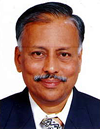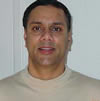Track: Cloud Computing
Wednesday, October 20 — 9:00 - 5:30
9:00 - 9:45
Case Study: A Cloud Based SaaS Solution Architecture for India's SM Business Groups Requirements
Sankaran Prithviraj, Principal Solution Architect, Mahindra Satyam
India is a nation of small enterprises; 99% of business in India fall under Small and Medium Sized business (SMB) segment; They are responsible for 50% of GDP and 40% of country’s industrial output and 35% of direct exports.
This paper describes private-cloud based SaaS solution that is specifically architected for conglomerate of companies. This paper summarizes conflicting and tough customers’ business requirements for which Cloud based SaaS is the only solution way-out.
Virtualization of hardware to set up a private cloud is easy first step. This paper describes engineering calculations to arrive at provisioning and de-provisioning while providing such SaaS solutions.
The solution required two major ABBs; one of them can be met by a fully cloud compatible SaaS ready COTS product (or SBB). This presentation illustrates how to build a solution architecture (to meet one of the ABBs) using a cloud compatible COTS (as SBB) product.
The market is not yet ready to offer a fully SaaS compatible COTS products to offer Cloud based solutions even for most common SBBs required to meet an enterprise solution ABBs. Hence challenges lie in taking less SaaS matured product and provide SaaS solutions.
This presentation illustrates how less matured (for cloud Compatible) COTS product can be used to provide SaaS solution.
The session will also include a practical demonstration of one of the solutions.
Key Takeaways:
- A typical customers’ tough and conflicting requirements where SaaS is the only solution out
- Precise engineering calculation for arriving at provisioning and de-provisioning of hardware and infrastructural wares
- A typical SaaS Solution Architecture for “Long Tails” use in India
- How to use less matured SaaS compatible product to provide still a good SaaS solution
Sankaran Prithviraj, Principal Solution Architect, Mahindra Satyam
 Sankaran Prithviraj, the author is Principal Architect and Solution Consultant in Mahindra Satyam and has about 28 years of experience in the information technology industry. In the recent times, he has published several papers on Enterprise Architecture and using TOGAF™. Sankaran Prithviraj, the author is Principal Architect and Solution Consultant in Mahindra Satyam and has about 28 years of experience in the information technology industry. In the recent times, he has published several papers on Enterprise Architecture and using TOGAF™.
Prithviraj has also published papers on "Engineering Well-Formed Services" in the context of SOA. (Use 'Sankaran Prithviraj' as search string to locate his papers and his profile.) He primarily provides solution architecture to customers on several enterprise systems as well architects solutions for integrating several enterprise systems. He has formal degrees BE, M.Tech - in four branches of engineering Metallurgy, Aeronautics,
Production Technology and Computer Science and engineering from India's most reputed educational Institutes Indian Institute of Science, Bangalore and Indian Institute of Technology, Madras.
9:45 - 10:30
Business Perspective to Buying Cloud
Penelope Gordon, Cloud and Business Architect, 1Plug Corporation
What is hindering cloud adoption? Most potential buyers are not willing to translate pricing and SLAs from IT into business terms, but most sellers are not offering solutions expressed in business terms and which directly address business needs. In this session I will outline how to use the cloud business artifacts developed by the Cloud Work Group of The Open Group to buy the optimal cloud solutions without understanding the underlying technology.
Audience:
Potential buyers and sellers of cloud solutions, and individuals making recommendations to those buyers.
Key takeaways:
- How to determine if some form of cloud might be an attractive choice for your business situation
- How to establish your business case including an expression of your requirements
- How to negotiate the terms and conditions governing solution delivery with sellers and stakeholders
Penelope Gordon, Cloud and Business Architect, 1Plug Corporation
 Penelope specializes in adoption strategies for emerging technologies, and portfolio management of early stage innovation. While with IBM, she led innovation, strategy, and product development efforts for all of IBM's product and service divisions; and helped to design, implement, and manage one of the world's first public clouds. Penelope specializes in adoption strategies for emerging technologies, and portfolio management of early stage innovation. While with IBM, she led innovation, strategy, and product development efforts for all of IBM's product and service divisions; and helped to design, implement, and manage one of the world's first public clouds.
|
10:30 - 11:00
BREAK
11:00 - 11:45
Case Study: Risk and Return of Cloud Computing - identifying practical actions to manage adoption and risk assessment
Mark Skilton, Global Director, Capgemini
An overview of security, risk and return, providing guidance on risk assessment, ROI (contrasting cloud to traditional investment), and models to help decision making. The session will walk through a couple of general case studies to illustrate the current risks and benefits of Cloud Computing adoption facing enterprises. It will provide examples of key metrics for risk management and identify specific activities Enterprises both large and small need to establish a cloud risk management approach that might include the following key processes and activities. The session will explore these topics through the case studies:
- Conduct Assessments of the opportunities and use cases of cloud computing to test cases to understand the technical and business risks of cloud.
- Develop and Establish Governance requirements for cloud operations. Identify who owns cloud in the business from a user perspective and a service provider management perspective ?
- Identify the tools needed to monitor and manage application development and infrastructure development lifecycles
- Determine Data and privacy classification to prioritise risk criteria of what goes in the cloud and what stays on-premise
- Identify Demand - for cloud resources and tactical projects and work towards common cloud standards usage, identifying "cloud champions" and service users along the way
- Choose Strategic Partners and Vendors -identify which vendors and partners to work with, testing vendors and establishing requirements that fit your organization
- Using benchmarks to validate project requests for the cloud. Creation of Cloud scorecards and specialist Cloud benchmarking procedures to assess projected and actual ROI. This submission is based on a presentation to the ICAEW Charted Institute of Accountants for England and Wales Cloud Computing for Accountants by the IT Faculty to leading CFOs and accountants cross-iIndustry. It draws on materials Mark has developed from real case studies and a recent paper on Cloud Computing ROI by The Open Group which is published in the 2010 Year book Journal of the British Computer Society.
Audience:
IT personnel responsible for Cloud Computing Project Assessments and Delivery
Key takeaways:
- Identify key risk and issues to cloud computing and the cost and value impact of these.
- Define examples of enterprise cloud risk management actions companies are using to manage cloud risk and adoption.
- Example Cloud Computing Scorecards and practical methods for Cloud Risk quantification.
Mark Skilton, Global Director, Capgemini
 Mark Skilton is currently Global Director for Capgemini Global Application Outsourcing. His role includes strategy development, global delivery readiness and creation of Centers of Excellence. He is currently author of the Capgemini University Cloud Computing Course. Mark has published a number of articles on Cloud Computing through The Open Group including CIO.com, ZDnet.com , CloudComputingJournal.com and guests on iTunes Cloud Blogs and is co-chair of The Open Group Cloud Computing Workgroup, Cloud Business Artifacts Project. He is a regular conference speaker and panel member on Cloud Computing thought leadership. Mark Skilton is currently Global Director for Capgemini Global Application Outsourcing. His role includes strategy development, global delivery readiness and creation of Centers of Excellence. He is currently author of the Capgemini University Cloud Computing Course. Mark has published a number of articles on Cloud Computing through The Open Group including CIO.com, ZDnet.com , CloudComputingJournal.com and guests on iTunes Cloud Blogs and is co-chair of The Open Group Cloud Computing Workgroup, Cloud Business Artifacts Project. He is a regular conference speaker and panel member on Cloud Computing thought leadership.
11:45 - 12:30
Interactive Q&A with morning speakers
Moderator: Chris Harding, The Open Group
12:00 - 12:30
Q&A
12:30 - 2:00
LUNCH
2:00 - 2:45
Effectively addressing challenges of Cloud Computing
Tejpal (TJ) Virdi, Computing Architect, The Boeing Company
All enterprises, regardless of their size, are currently facing economic pressure to optimize their IT delivery model. One of the leading trends is to utilize cloud computing to enable flexible, easily managed, and potentially lower cost IT delivery environment. Although emerging cloud computing could be an alternative to traditional IT delivery model, hastily adapting the cloud without realizing its impact on existing business services could have dire consequences and will cause breakage in business processes and operational controls.
This presentation highlights the use of SOA style to systematically addressing the challenges of utilizing cloud delivery model. It defines an approach to ensure that information and its underlying data are separated from applications and business processes to effectively support many applications over the cloud. The presentation also highlights the values of efficiently integrating distributed content in a standardized manner. It outlines an approach to progressively evolve disparate applications and transform them into a well connected information sources by organizing the underlying data in a well represented vocabulary terms. It identifies an approach to enable SOA services that are semantically interoperable to be able to support many applications. These services utilize enterprise security strategies that adapt to evolving business cases by effectively protecting business information from unauthorized use in a distributed delivery environment.
Audience: Business and IT executives, Enterprise architects, Application/System designers, Information/Data Architects, Business architects
Key takeaways:
- An approach to evolve existing applications for cloud IT delivery model.
- Ensuring that enterprise business services and underlying data are substantially evolved in a standardized manner to effectively support multiple applications over the cloud.
Tejpal (TJ) Virdi, Computing Architect, The Boeing Company
 Tejpal (TJ) Virdi is currently working with The Boeing Company as a Computing Architect in CAS IT Architecture group. TJ is primarily responsible for architectural leadership, aligning vision and strategy with enterprise information systems. Prior to joining The Boeing Company, TJ had worked in Healthcare IT for 15+ years in creating and managing innovative solutions. Tejpal (TJ) Virdi is currently working with The Boeing Company as a Computing Architect in CAS IT Architecture group. TJ is primarily responsible for architectural leadership, aligning vision and strategy with enterprise information systems. Prior to joining The Boeing Company, TJ had worked in Healthcare IT for 15+ years in creating and managing innovative solutions.
TJ has an MBA, Bachelor of Science and Bachelor of Commerce degree. TJ is also TOGAF 9.0 and Sun Microsystems J2EE Enterprise Architect certified.
2:45 - 3:30
Cloud, the Enterprise, and the Enterprise Architect: Convergence that Drives Sustainable Business Value
Pamela Isom, Executive Enterprise Architect, IBM
What are the implications of using Cloud computing in the enterprise? Why is it essential that the convergence of Cloud in your enterprise occur and where does Enterprise Architecture fit in all of this? How can the Enterprise Architect be more effective in identifying and expressing the business requirements for (or deliberate omission of) Cloud computing?
This is a how-to, collaborative session that describes Cloud considerations for an enterprise and the critical role of the enterprise architect in the planning and adoption cycles. The session describes how the three (Cloud, the Enterprise, and the Enterprise Architect) must come together to drive sustainable value and business outcomes. Specifically I paraphrase conversations of a Chief Enterprise Architect with senior stake-holders (COO and CIO) that attributed to top-down organizational support of Cloud as a business strategy. Together we will analyze the results of Cloud adoption in the enterprise using applied project experiences including how we developed actionable road-maps. During the session I will also demonstrate how to apply some key work artifacts that The Open Group's Cloud Business Use Case team developed to help you address specific business challenges including how Cloud can be a risk mitigator for your business.
Audience:
Senior Executives, Senior Enterprise Architects, Business Leaders
Key takeaways:
- Real-life business and technology outcomes of using Cloud in the enterprise
- The significance of the Business Architect and Cloud
- Practical guidance and techniques that you can apply today
Pamela Isom, Executive Enterprise Architect, IBM
 Pamela K. Isom is a Senior Certified, Executive IT Architect with IBM Global Business Services. Pam joined IBM in June, 2000 and leads efforts that drive Smarter Planet efficiencies (such as Cloud and Smarter Buildings) throughout client enterprises by using, and often times enhancing its Enterprise Architecture (EA). Currently Pam operates as the Chief Enterprise Archtiect on client engagements, and a business strategy consultant for Green solutions. She is the lead author of the publication Intelligent Enterprise Architecture, an invention and IBM offering supporting business technology enablement using Cloud and other emerging technologies (IEEE/IBM Journal of Research and Development-July / Aug 2010). Externally, Pam is a member of IEEE and an active contributor to The Open Group where she co-leads research and development of Cloud business use cases and strategies for Cloud adoption. Pam is a recent graduate of Walden University where she holds a Master of Information Systems Management with specialization in Business Information Management. Pamela K. Isom is a Senior Certified, Executive IT Architect with IBM Global Business Services. Pam joined IBM in June, 2000 and leads efforts that drive Smarter Planet efficiencies (such as Cloud and Smarter Buildings) throughout client enterprises by using, and often times enhancing its Enterprise Architecture (EA). Currently Pam operates as the Chief Enterprise Archtiect on client engagements, and a business strategy consultant for Green solutions. She is the lead author of the publication Intelligent Enterprise Architecture, an invention and IBM offering supporting business technology enablement using Cloud and other emerging technologies (IEEE/IBM Journal of Research and Development-July / Aug 2010). Externally, Pam is a member of IEEE and an active contributor to The Open Group where she co-leads research and development of Cloud business use cases and strategies for Cloud adoption. Pam is a recent graduate of Walden University where she holds a Master of Information Systems Management with specialization in Business Information Management.
3:30 - 4:00
Break
4:00 - 4:40
The Open Group's Cloud Security Architecture
Stuart Boardman, Senior Business Consultant, Getronics Consulting
The purpose of this session is to create an interactive environment in which participants can both learn from the work already performed by the Security for the Cloud project and contribute to its further development. The emphasis will be primarily on use cases and the conceptual architecture - placed within the context of the principles adopted by the project and the architectural building blocks we have defined. Participants can learn both from the experience reflected in the work to date and from the ability to discuss their own ideas in an open and constructive environment.
Audience:
Architects and security specialists
Stuart Boardman, Senior Business Consultant, Getronics Consulting
 Stuart is a Senior Business Consultant and Architect with Getronics Consulting. He specializes in SOA, Identity and Access Management (IAM) and Cloud Computing, and in particular in the intersection of these areas. He has been active in The Open Group's SOA and Cloud Work Groups since their inception and is co-chair of the Security for the Cloud project. Before getting into the IT business Stuart tried to make his living as a professional musician and also regards himself as an unrepentant hippie. This perhaps explains his special interest in the topic of Identity. Stuart is a Senior Business Consultant and Architect with Getronics Consulting. He specializes in SOA, Identity and Access Management (IAM) and Cloud Computing, and in particular in the intersection of these areas. He has been active in The Open Group's SOA and Cloud Work Groups since their inception and is co-chair of the Security for the Cloud project. Before getting into the IT business Stuart tried to make his living as a professional musician and also regards himself as an unrepentant hippie. This perhaps explains his special interest in the topic of Identity.
4:40 - 5:30
Panel: Building Cloud into your Enterprise Architecture
Interactive Q&A with audience
 Return to previous page Return to previous page
|